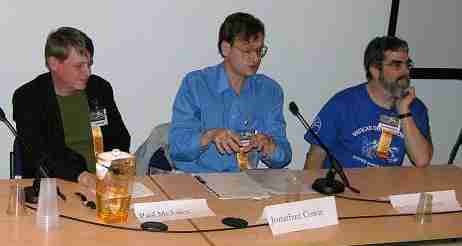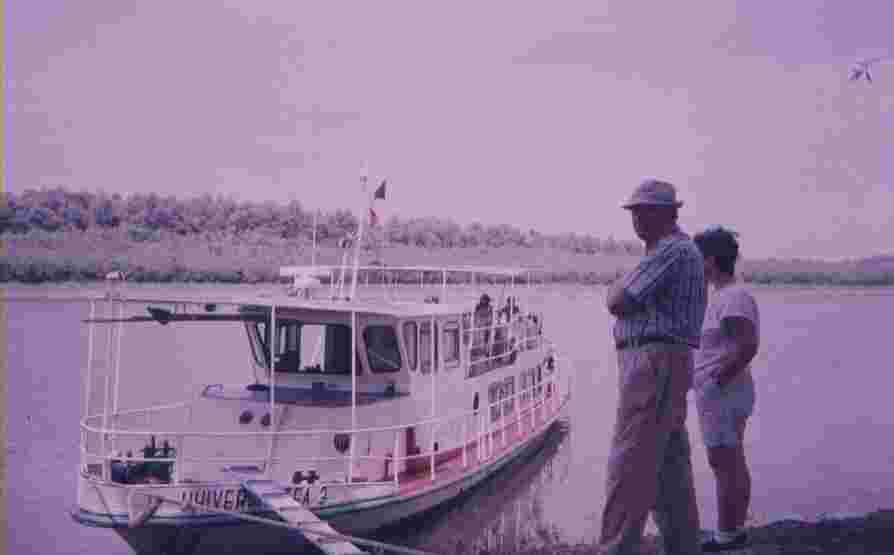|
Science fiction interactions
Science fiction (SF) provides a hook for an interest in science fact. This has been demonstrated in a few professional surveys of science graduates, the book trade and the general population both in the UK and US. The results of such professional surveys also tie in with less formal ones of the science fiction community. This is not to say that involving SF in science communication exercises is the be and end all, but it is a dimension that is overlooked when seeking to foster an interest in, and an appreciation of, science in society. Further it is not to say that SF itself engenders an increase in scientific understanding, what it does (and this has been repeatedly demonstrated) is to foster an interest in science fact and provide a vehicle for public discussion over issues of concern that are underpinned by science. That this is so is demonstrated by the success of some science (and natural history) museum exhibitions that employ SF as a hook as well as by the advertising industry that occasionally uses SF tropes to market products from banking services to (famously in the UK) instant mashed potato.
Jonathan Cowie has engaged in a number of activities that cross the boundary between science fact and fiction while ensuring that the two are not confused. Many of these, such as providing science research contacts for SF authors and publishers to participating on panel discussions and giving science talks at SF conventions, take place in the UK. However there is a thin line between science fact and fiction and some scientists are wary of adverse publicity lest fact and fiction be confused. In deference to such concerns the following are just a couple of examples of science fact and fiction activities that have taken place outside of the UK in Eastern Europe.
Example 1. 2001 Danube biosphere reserve and a science fact and fiction youth camp. An invitation to be a guest at a UNESCO sponsored youth camp in the Danube biosphere reserve provided not only an opportunity to interact with the young (including some of the next generation of scientists) and SF authors fro both Europe and the US, but also separately be shown parts of the biosphere reserve by members of the Romanian Ecological Society. The youth camp itself had theme days that alternated between science and science fiction. The Concatenation Science contribution was to lead a day on genetics during which the principles and implications of genetic engineering were discussed. Postgraduate students helped lead the science discussion while SF authors were on hand to help illuminate likely consequences and ethical concerns (occasionally illustrating these with possible story plot outlines). Appropriately that year had seen the publication of the draft of the human genome. Separately the visit to the region enabled Jonathan to visit a number of the biosphere reserve's sites of scientific interest courtesy of the Romanian Ecological Society (RES) and Prof Vadineanu (former Secretary of State for the Environment and then President of the RES). Outputs: Interest in genetics was fostered among the youth group. The draft human genome project featured on a Romanian educational video for school use. A report of the reserve visit appeared in the British Ecological Society's BES Bulletin and this in turn lead to a 2003 visit by officers of the BES to Romania to meet RES counterparts to identify areas of cooperation. Separately to both these there was an opportunity for a personal visit the nuclear reactor at Cernovoda which in turn led to further discussion with members of the Canadian nuclear industry at Canada House in London at an event co-organised by the Uranium Institute.
Example 2. An International Science Fact and Fiction conference co-sponsored by the Timisoara branch of the Romanian Writers Association. This event was also sponsored by the Science Fact & Fiction Concatenation (more of which later). This event took place in 1999 and lasted a week. It primarily involved science fiction enthusiasts in Timisoara but also included the wider public at a book launch. Not only were science fiction books and films discussed during the week, US author Robert Sheckley and Italian writer Roberto Quaglia were on hand together with half a dozen Romanian writers. In addition to the SF science fact appeared on the conferences programme mainly in the guise of astronomical talks. This was because the conference was deliberately timed to coincide with an eclipse of the Sun with Timisoara along the line of totality. Prior to the week Jonathan went on a lecture tour speaking to Hungarian and Romanian audiences on the relationship between biology and astronomy (which may be greater than you think as it is possible to use fossils to work out the distance between the Earth and the Moon in the geological past). Outputs: Aside from reaching an immediate audience the Biology of Astronomy talk was recorded by regional TV. The event also led to a follow-up activity whereby a Romanian and a Hungarian were both sponsored for a science fact and fiction cultural exchange visit to Great Britain which in turn included a visit to the Royal Society and the Natural History Museum as well as that year's UK national SF convention. In turn secondary outputs, from this visit to Britain, included a broadcast to Hungary from the BBC World Service and a series of six articles in a Hungarian newspaper. Overall the Romanian conference venture was sufficiently successful that a second week-long event was organised in 2003. This also had its outputs, but there is not enough space to list these here.
Beyond the world of science and within the international science fiction community 'Concatenation' is not associated with 'science~com.concatenation' but the The Science Fact and Fiction Concatenation. This is run by a rather loose band of a score or so who inititially (1987) produced a print magazine that moved to the internet (1999 - the present). The Science Fact and Fiction Concatenation is primarily a resource for science fiction enthusiasts by enthusiasts many of whom are scientists, and so in part it has a science perspective. In addition to the website the team have been involved in other projects including helping organise the above (see 'example 2') week-long conferences.
| 






